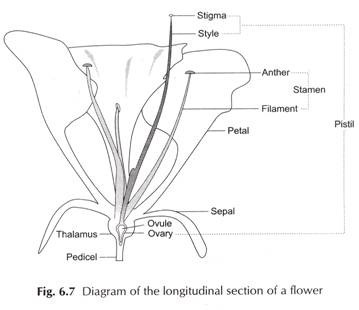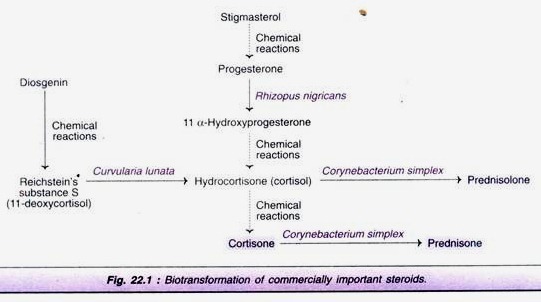ADVERTISEMENTS:
Sexual Reproduction in Flowering Plants!
The reproductive part of a flowering plant is the flower.
Flowers are considered to be modified shoots.
Parts of a Flower:
Most flowers have both the male and female reproductive organs, but some bear either the male or the female sex organs. Such flowers are known as unisexual flowers (e.g., watermelon, cucumber, etc.) Those flowers which have both sex organs are known as bisexual flowers (e.g., Hibiscus, pea, etc.) A flower generally bears a long or short axis.
ADVERTISEMENTS:
This axis has two parts—the stalk of the flower, called pedicel, and its swollen top called thalamus. The parts of a flower are arranged on the thalamus (Figure6.7).
A typical flower consists of four sets of floral parts, or whorls: calyx (sepals), corolla (petals), androecium (stamens) and gynoecium (carpels). Calyx and corolla are not directly involved in reproduction.
ADVERTISEMENTS:
Androecium and gynoecium are directly concerned with sexual reproduction. The androecium is the male part of the flower and consists of stamens. The gynoecium (or pistil) consists of carpels and is the female reproductive part. The whorls are arranged on the thalamus of a flower in a definite sequence.
Calyx:
Calyx is the outermost whorl. It consists of sepals. The sepals are usually green, but sometimes they may be coloured. Calyx protects the floral whorls in the bud stage.
Corolla:
Corolla, the next inner whorl, consists of petals. Petals may be white or brightly coloured. They attract insects towards the flower and thus help in pollination. Corolla protects the reproductive whorls in the bud stage.
Androecium:
The stamens are collectively called androecium, which is the third whorl. Each stamen consists of a filament and an anther. Each anther has two chambers called pollen sacs. If you touch the stamens of a flower, a yellowish powder may come off on your hands. Anthers produce these numerous yellowish pollen grains, which contain male gametes.
Gynoecium:
The gynoecium (or pistil) is in the centre of the flower. It is the fourth whorl. It bears the female reproductive organ, called carpel. Each carpel consists of three parts—a basal swollen portion called ovary, a narrow stalk like middle portion called style and a one- to many-lobed flattened disc like sticky structure called stigma at the top of the style.
The ovary is surrounded by an outer wall. The ovary may be divided into chambers. The chambers contain ovules. Each ovule has an egg cell (female gamete).
Pollination:
The transfer of pollen grains from the anthers of a flower to the stigma of the same or another flower is known as pollination.
The transfer of pollen to the stigma of the same flower or of flowers borne by the same plant is known as self-pollination (as in pea and Hibiscus). Cross-pollination is the transfer of pollen from the anthers of a flower to the stigma of a flower on another planet of the same species. It is very common in most flowering plants.
ADVERTISEMENTS:
Pollen can be carried with the help of many agents such as insects, birds, wind and water. Flowers and pollen grains are modified to facilitate the process of cross-pollination. For example, insect-pollinated flowers are colorful so that they attract insects. Wind-pollinated flowers produce light pollen grains which can be carried by the wind.
Fertilization:
The pollen grains germinate on the stigma after pollination. The inner wall of the pollen grain grows into a pollen tube, which grows down through the style and finally reaches the ovule. Inside the ovule, a male gamete fuses with the female gamete and a zygote is formed. This is known as fertilization.
The zygote divides repeatedly to form the embryo (future plant) in the ovule. The embryo possesses a tiny future root (radicle), a tiny future shoot (plumule) and cotyledons to store food. The ovary grows rapidly to form the fruit. The ovary wall ripens and forms the fruit wall. The sepals, petals, stamens, style and stigma of the flower degenerate and usually fall off.
Sometimes the sepals may persist in the fruit. The ovule develops into a seed. The wall of the ovule thickens to form the protective seed coat. The seed loses water and becomes hard and dry. Seeds can withstand drought and other adverse conditions in this state. This is an advantage for seed-producing plants.
ADVERTISEMENTS:
The embryo lies dormant in the seed, but under favourable environmental conditions it becomes active and germinates to form a small seedling. The radicle forms the root while the plumule forms the shoot. The growing root and shoot utilize the food stored in the cotyledons.


